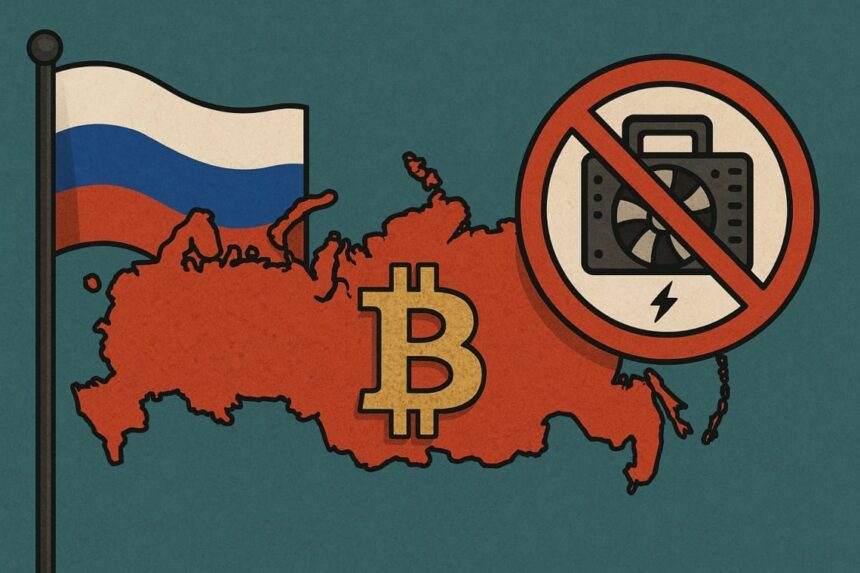The government of Russia is considering extending the restrictions against Bitcoin mining to new areas of the country, in an attempt to address the growing issues related to electrical consumption and energy stability.
After several regions had already introduced similar measures, three new administrative entities have proposed to adopt limitations that could significantly alter the map of Russian mining.
Pressure increases for Bitcoin mining: three more regions request limitations like Russia
Karelia (northern part), the Penza region, and some areas of Khakassia have formally submitted requests to obtain authorization to reduce, or in certain cases prohibit, operations related to cryptocurrency mining.
It was confirmed by the Ministry of Finance of the Russian Federation, although without going into details on what type of measure will be adopted – whether a total ban or seasonal limitations.
The context is clear: these regions share severe climatic characteristics and outdated energy infrastructures, frequently stressed by blackout and winter storms.
Mining – this computationally intensive activity necessary to validate Bitcoin transactions – consumes enormous amounts of electrical energy, burdening an already fragile grid and making it difficult to provide regular electricity supply to citizens.
In particular, in the region of Penza, anomalous peaks in energy consumption have been recorded. The authorities have found that some homes consume up to 70% more than normal.
This triggered the alarm: it is suspected that there are illegal mining operations hidden behind the apparent normality of the residential units.
The local institutions, consequently, have intensified the monitoring of the network and power lines, to identify and counter these unauthorized activities.
The requests from Karelia, Penza, and Khakassia are not an isolated case. Only in the month of December, numerous federal entities and autonomous regions in Russia have already adopted restrictive measures or outright bans on mining activity.
Among these stand out names like Daghestan, Inguscezia, Cabardino-Balcaria, Karachaj-Circassia, Ossezia del Nord and Cecenia.
To these are also added the Repubbliche popolari di Donetsk e Lugansk, in addition to the annexed areas of Zaporizhzhia and Kherson.
The risks of a side effect: mining goes underground
These areas share favorable environmental conditions for mining: consistently low temperatures that facilitate the cooling of devices and reduced electricity rates, making them ideal grounds for the activity.
However, these very conditions have also attracted operations whose legality and transparency are often questioned, contributing to a growing instability of the local electrical grid.
Despite regulatory efforts, some fear that these restrictive measures may have an opposite effect to the one desired.
According to some critics, the divieti di mining risk spingere l’intero settore nell’illegalità, making it much more difficult to monitor the actual energy consumption and adopt adequate control measures.
Once “underground,” these activities could continue to exist without the authorities having a way to intervene effectively.
This would mean increasing the risks both in terms of blackouts and in terms of the safety of electrical installations, already strained by the age of the infrastructure.
Despite the concerns, the initial signs emerging from the regions that have already implemented these measures seem encouraging.
The Ministero dell’Energia russo, in fact, has communicated that in Siberia – one of the areas with the highest mining activity – the overall load on the network has dropped by over 300 megawatts.
This significant drop has allowed for the avoidance of widespread restrictions that could have harmed the population, thus ensuring a more stable and consistent electricity supply.
This is a result that could motivate further regions to follow the example, adopting targeted and temporary measures to protect the network, especially during the colder months, when the energy demand for heating reaches the annual highs.
A delicate balance between innovation and infrastructures
The ongoing debate in Russia on the future of cryptocurrency mining raises crucial questions about how to balance technological innovation with the sustainability of energy resources.
On one hand, the mining industry represents an innovative and potentially profitable economic engine; on the other hand, its impact on aging energy infrastructures, especially in the more remote areas, cannot be ignored.
The main challenge for the Russian government is therefore to find a balance between control of energy consumption and the promotion of a secure, regulated, and sustainable digital environment.
While waiting for the Ministry of Finance to precisely define the measures that will be implemented in Karelia, Penza, and Khakassia, the signal is clear: the hard line against wild mining is set to strengthen in the coming months.
Thus changing the face of one of the most strategic hubs for global mining.











